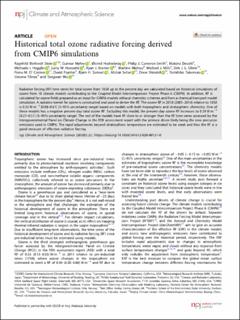| dc.contributor.author | Skeie, Ragnhild Bieltvedt | |
| dc.contributor.author | Myhre, Gunnar | |
| dc.contributor.author | Hodnebrog, Øivind | |
| dc.contributor.author | Cameron-Smith, Philip J. | |
| dc.contributor.author | Deushi, Makoto | |
| dc.contributor.author | Hegglin, Michaela I. | |
| dc.contributor.author | Horowitz, Larry W. | |
| dc.contributor.author | Kramer, Ryan J. | |
| dc.contributor.author | Michou, Martine | |
| dc.contributor.author | Mills, Michael J. | |
| dc.contributor.author | Oliviè, Dirk Jan Leo | |
| dc.contributor.author | O’Connor, Fiona M. | |
| dc.contributor.author | Paynter, David | |
| dc.contributor.author | Samset, Bjørn Hallvard | |
| dc.contributor.author | Sellar, Alistair | |
| dc.contributor.author | Shindell, Drew | |
| dc.contributor.author | Takemura, Toshihiko | |
| dc.contributor.author | Tilmes, Simone | |
| dc.contributor.author | Wu, Tongwen | |
| dc.date.accessioned | 2021-08-25T10:34:38Z | |
| dc.date.available | 2021-08-25T10:34:38Z | |
| dc.date.created | 2020-09-29T20:47:52Z | |
| dc.date.issued | 2020 | |
| dc.identifier.issn | 2397-3722 | |
| dc.identifier.uri | https://hdl.handle.net/11250/2771140 | |
| dc.description.abstract | Radiative forcing (RF) time series for total ozone from 1850 up to the present day are calculated based on historical simulations of ozone from 10 climate models contributing to the Coupled Model Intercomparison Project Phase 6 (CMIP6). In addition, RF is calculated for ozone fields prepared as an input for CMIP6 models without chemistry schemes and from a chemical transport model simulation. A radiative kernel for ozone is constructed and used to derive the RF. The ozone RF in 2010 (2005–2014) relative to 1850 is 0.35 W m−2 [0.08–0.61] (5–95% uncertainty range) based on models with both tropospheric and stratospheric chemistry. One of these models has a negative present-day total ozone RF. Excluding this model, the present-day ozone RF increases to 0.39 W m−2 [0.27–0.51] (5–95% uncertainty range). The rest of the models have RF close to or stronger than the RF time series assessed by the Intergovernmental Panel on Climate Change in the fifth assessment report with the primary driver likely being the new precursor emissions used in CMIP6. The rapid adjustments beyond stratospheric temperature are estimated to be weak and thus the RF is a good measure of effective radiative forcing. | en_US |
| dc.language.iso | eng | en_US |
| dc.publisher | Springer Nature Ltd | en_US |
| dc.rights | Navngivelse 4.0 Internasjonal | * |
| dc.rights.uri | http://creativecommons.org/licenses/by/4.0/deed.no | * |
| dc.title | Historical total ozone radiative forcing derived from CMIP6 simulations | en_US |
| dc.type | Journal article | en_US |
| dc.type | Peer reviewed | en_US |
| dc.description.version | publishedVersion | en_US |
| dc.source.volume | 3 | en_US |
| dc.source.journal | npj Climate and Atmospheric Science | en_US |
| dc.source.issue | 32 | en_US |
| dc.identifier.doi | https://doi.org/10.1038/s41612-020-00131-0 | |
| dc.identifier.cristin | 1835174 | |
| dc.relation.project | Norges forskningsråd: 295046 | en_US |
| dc.relation.project | Notur/NorStore: NS9252K | en_US |
| dc.relation.project | Notur/NorStore: NS9188K | en_US |
| dc.relation.project | Notur/NorStore: NN9188K | en_US |
| cristin.ispublished | true | |
| cristin.fulltext | original | |
| cristin.qualitycode | 1 | |

